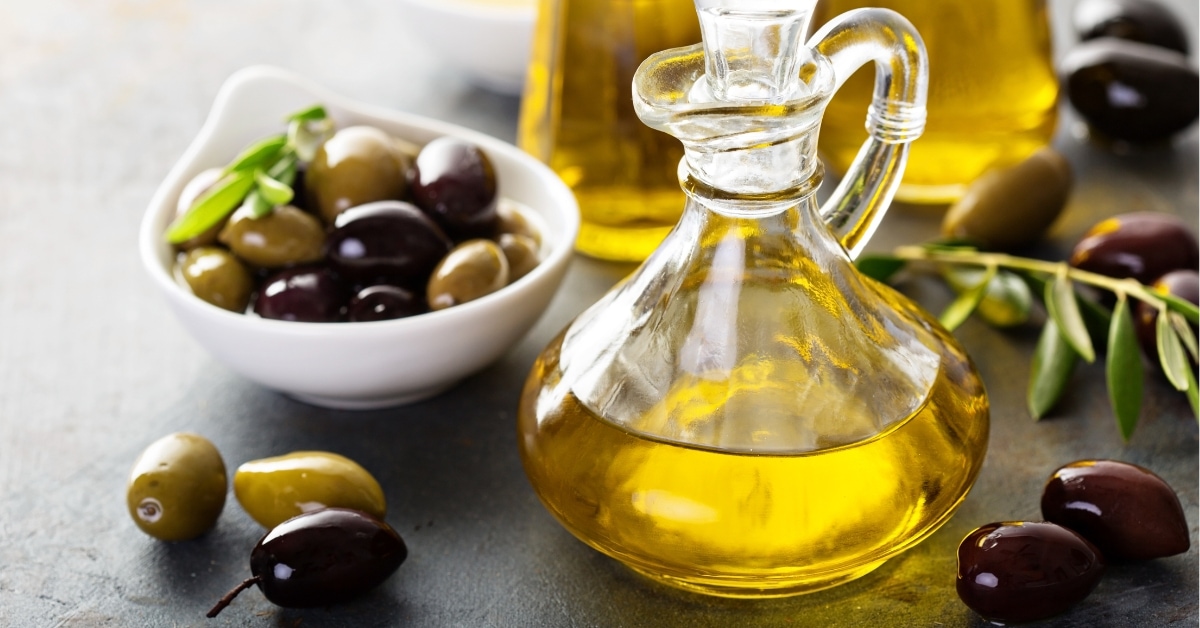Navigating the oil aisle can be confusing with similar choices like regular and extra virgin olive oil.
Here’s a little insight: while they both hail from the same fruit, the extraction methods set them apart. Extra virgin olive oil is minimally processed and untouched by chemicals.

Regular olive oil undergoes more processing, giving it a milder profile. They also differ in price and how they’re used.
Let’s break it down and help you decide which one to pick for your next dish.
Regular vs. Extra-Virgin Olive Oil (What’s the Difference?)
Despite their similar names, there are notable differences between virgin and extra virgin olive oil (EVOO).
The classification of olive oil by the International Olive Council (IOC) depends on the oil’s fatty acid content and nutrients.
EVOO is held to a standard of no more than 0.8% free acidity. Virgin olive oil can contain up to 2% free acidity.
Let’s take a closer look at the differences between the two.
Production Process
EVOO is derived from the most pristine methods, ensuring purity at every step.
EVOO must be devoid of flaws, such as unusual acidity levels, bitterness, or pungency.
Meanwhile, regular olive oils undergo a heating phase. The fruit pulp is exposed to elevated temperatures, enabling the juice to separate from the fruit.
Also, the refining techniques used for cheaper olive oils often rob them of their nutrients and vitamins.

Taste
Extra virgin olive oil has a deep color ranging from golden to a deep green.
This color is a testament to its robust flavor, influenced by the type of olives used.
The natural compounds in EVOO, known as phytochemicals, also lend distinct flavor notes.
Some EVOOs are reminiscent of fresh fruit, while others are of green grass. Some even have a hint of spiciness.
Regular virgin olive oil has a lighter color and a more subdued taste profile. This is due to its subsequent pressings and heat processing.
This milder flavor can be advantageous when you don’t like the intensity of EVOO to overpower your dish.
Regular virgin olive oil can also be slightly more acidic than EVOO.
Smoke Point
Extra virgin olive oil is suitable for roasting, baking, and sautéing. But with a smoke point of 350 degrees Fahrenheit, frying with it isn’t recommended.
Some even believe extra virgin olive oil is best not heated, especially if cold-pressed and unfiltered.
The heat can diminish the effectiveness of some of EVOO’s beneficial compounds. To get the most out of its nutrients, it’s ideal for dressings or as a finishing touch.
Regular olive oil can handle more heat. Its smoke point ranges from 420 to 470 degrees Fahrenheit.
This makes it fit for frying, though it’s not the healthiest method.
Compared to other oils, olive oil remains more stable at high temperatures. This stability lowers the chances of harmful compounds forming during cooking.
Best Uses
Regular olive oils are milder in taste. EVOO is the top choice for dishes where the oil’s flavor is paramount. For salad dressings or dips, EVOO’s distinct flavor shines through.
The unique taste and scent of EVOO arise from its sensitive chemical makeup. This can degrade under high heat. So, saving pricey EVOO for low to no-heat applications is best.
EVOO boasts more antioxidants than regular olive oil and is richer in monounsaturated fats. For heart health benefits, EVOO stands out as the better choice.
For tasks like frying or browning meats, regular olive oil is superior. Its higher smoke point makes it suitable for higher-temperature cooking than EVOO.
Standard olive oil is recommended for heat levels exceeding 350-415 degrees Fahrenheit.
Price
Extra virgin olive oil costs more than regular olive oil. Making EVOO takes a lot of work, as many olives are handpicked and pressed.
You pay more for EVOO, but you get better quality.

What Is Olive Oil?
Olive oil is obtained by pressing the fruits from olive (Olea Europaea) trees. These trees are native to the Mediterranean region.
Major olive oil producers include Spain, Italy, Greece, and Turkey, with the U.S. steadily contributing.
Olive oil isn’t just for cooking. It’s also an ingredient in soaps, cosmetics, and medicines. It’s even used in religious ceremonies and traditional lighting methods.
The best and oldest technique for producing olive oil is to crush olives between large stones and press the pulp to extract the oil.
The quality of olive oil depends on how it’s processed. Minimal heat during processing is ideal.
The extraction method, refinement level, and blending affect the oil’s grade and price point.
Refined vs. Unrefined Olive Oil
Olive oil can be categorized as refined or unrefined.
Unrefined oils are untouched and pure. Refined oils undergo heating and filtering to eliminate imperfections.
Refining olive oil diminishes its aroma, changes its color, and mutes its flavor. The refining process also decreases its antioxidant and anti-inflammatory benefits.
Refined oils don’t have the characteristic bitterness of unrefined oils.
It’s a good idea to have two olive oil types: one for regular cooking and another for finishing dishes like salads and soups.

What Is Extra-Virgin Olive Oil?
Extra virgin olive oil is the purest, unrefined form of olive oil. It keeps its unique flavor and healthful nutrients since it’s not processed with heat or chemicals.
The careful production ensures the oil retains its natural goodness and doesn’t lose its health benefits.
To be labeled “extra virgin,” there’s a standard: the oil’s natural acidity must be 1% or less.
What Is Virgin Olive Oil?
Virgin olive oil is a step below extra virgin in quality. However, it’s still also unrefined, cold-pressed, and retains its natural flavor.
Unlike extra virgin, its oleic acid content can exceed 0.8%.
The International Olive Council sets these standards, which are slightly less strict than for extra virgin.
What Is Pure Olive Oil?
Pure olive oil, often labeled as “regular” olive oil, is a mix of virgin and refined olive oil.
Its quality sits below extra virgin and virgin oils.
It’s lighter in color, has a milder taste, and its oleic acid content ranges from 3-4%. Many use it as a versatile cooking oil.
What About Light Olive Oil?
“Light” in light olive oil doesn’t mean fewer calories. It’s about the mild flavor.
This refined oil has a neutral taste and a higher smoke point. It’s suitable for baking, sautéing, and frying.

Can They Be Substituted for Each Other?
Your choice between extra-virgin and regular olive oil depends on your taste preference.
But yes, you can substitute one for the other in recipes.
Both can be used in cooking and baking, but remember their different smoke points.
Extra virgin olive oil has a smoke point of 350 degrees Fahrenheit, so frying with it isn’t advised.
Regular olive oil can endure more heat, boasting a smoke point between 420 to 470 degrees Fahrenheit.
Extra-virgin olive oil’s distinct flavor is ideal for uncooked dishes, dips, and dressings. It’s also used for finishing dishes to highlight their taste.










